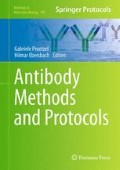Abstract
Antibodies as therapeutic agents have gained broad acceptance as shown by the number of antibodies in clinical use and many more in clinical development. This utility is an outcome of the high specificity and affinity of the antigen-binding site comprised of the heavy and light chain variable domains. In addition, the Fc portion of human or humanized IgG1 antibodies promotes long half-life through interaction with the recycling FcRn receptor and effects killing functions through interaction with complement and Fcγ receptors. Engineering the Fc portion to increase half-life through stronger binding to FcRn, or to increase complement or cell-mediated killing may lead to improved therapeutic antibodies. These improvements may benefit the patients through convenience in dosing or increased efficacy. Here we describe protocols for generating Fc-engineered IgG1 antibodies and assays to measure Fc receptor binding, antibody dependent cellular cytotoxicity activity, and complement dependent cytotoxicity activity to identify variants with improved FcRn binding or effector function.
Access this chapter
Tax calculation will be finalised at checkout
Purchases are for personal use only
References
Roopenian DC, Akilesh S (2007) FcRn: the neonatal Fc receptor comes of age. Nat Rev Immunol 7:715–725
Yeung YA, Leabman MK, Marvin JS et al (2009) Engineering human IgG1 affinity to human neonatal Fc receptor: impact of affinity improvement on pharmacokinetics in primates. J Immunol 182:7663–7671
Gessner JE, Grussenmeyer T, Schmidt RE (1995) Differentially regulated expression of human IgG Fc receptor class III genes. Immunobiology 193:341–355
van der Poel CE, Spaapen RM, van de Winkel JG et al (2001) Functional characteristics of the high affinity IgG receptor, FcgRI. J Immunol 186:2699–2704
Metes D, Ernst LK, Chambers WH et al (1998) Expression of functional CD32 molecules on human NK cells is determined by an allelic polymorphism of the FcγRIIc gene. Blood 91:2369–2380
Dutertre C-A, Bonnin-Gelize E, Pulford K et al (2008) A novel subset of NK cells expressing high levels of inhibitory FcγRIIb modulating antibody-dependent function. J Leukoc Biol 84:1511–1520
Cartron G, Dacheux L, Salles G et al (2002) Therapeutic activity of humanized anti-CD20 monoclonal antibody and polymorphism in IgG Fc receptor FcgRIIIa gene. Blood 99:754–758
Weng WK, Levy R (2003) Two immunoglobulin G fragment C receptor polymorphisms independently predict response to rituximab in patients with follicular lymphoma. J Clin Oncol 21:3940–3947
Shields RL, Namenuk AK, Hong K et al (2001) High resolution mapping of the binding site on human IgG1 for FcgRI, FcgRII, FcgRIII, and FcRn and design of IgG1 variants with improved binding to the FcgR. J Biol Chem 276: 6591–6604
Lazar GA, Dang W, Karki S et al (2006) Engineered antibody Fc variants with enhanced effector function. Proc Natl Acad Sci USA 103:4005–4010
Yamane-Ohnuki N, Kinoshita S, Inoue-Urakubo M et al (2004) Establishment of FUT8 knockout Chinese hamster ovary cells: an ideal host cell line for producing completely defucosylated antibodies with enhanced antibody-dependent cellular cytotoxicity. Biotechnol Bioeng 87:614–622
Shields RL, Lai J, Keck R et al (2002) Lack of fucose on human IgG1 N-linked oligosaccharide improves binding to human FcgRIII and antibody-dependent cellular toxicity. J Biol Chem 277:26733–26740
Mossner E, Brunker P, Moser S et al (2010) Increasing the efficacy of CD20 antibody therapy through the engineering of a new type II anti-CD20 antibody with enhanced direct and immune effector cell-mediated B-cell cytotoxicity. Blood 115:4393–4402
Idusogie EE, Wong PY, Presta LG et al (2001) Engineered antibodies with increased activity to recruit complement. J Immunol 166:2571–2575
Lu Y, Vernes JM, Chiang N, Ou Q et al (2011) Identification of IgG1 variants with increased affinity to FcγRIIIa and unaltered affinity to FcγRI and FcRn: comparison of soluble receptor-based and cell-based binding assays. J Immunol Methods 365:132–141
Kunkel TA, Roberts JD, Zakour RA (1987) Rapid and efficient site-specific mutagenesis without phenotypic selection. Methods Enzymol 154:367–382
Chung CT, Miller RH (1988) A rapid and convenient method for the preparation and storage of competent bacterial cells. Nucleic Acids Res 16:3580
Acknowledgments
We thank Devin Tesar for providing the protocol for surface plasmon resonance measurement of FcRn binding, Gerald Nakamura for advice on ADCC and CDC protocols, and Yanmei Lu for reviewing the Fc receptor binding ELISA protocols.
Author information
Authors and Affiliations
Corresponding author
Editor information
Editors and Affiliations
Rights and permissions
Copyright information
© 2012 Springer Science+Business Media, LLC
About this protocol
Cite this protocol
Kelley, R.F., Meng, Y.G. (2012). Methods to Engineer and Identify IgG1 Variants with Improved FcRn Binding or Effector Function. In: Proetzel, G., Ebersbach, H. (eds) Antibody Methods and Protocols. Methods in Molecular Biology, vol 901. Humana Press, Totowa, NJ. https://doi.org/10.1007/978-1-61779-931-0_18
Download citation
DOI: https://doi.org/10.1007/978-1-61779-931-0_18
Published:
Publisher Name: Humana Press, Totowa, NJ
Print ISBN: 978-1-61779-930-3
Online ISBN: 978-1-61779-931-0
eBook Packages: Springer Protocols

